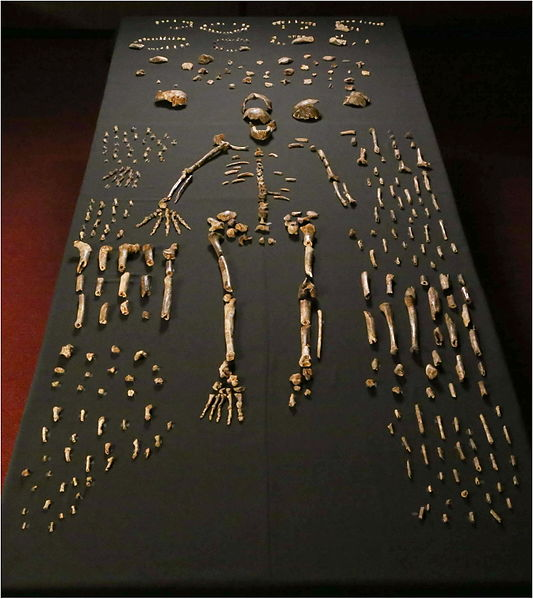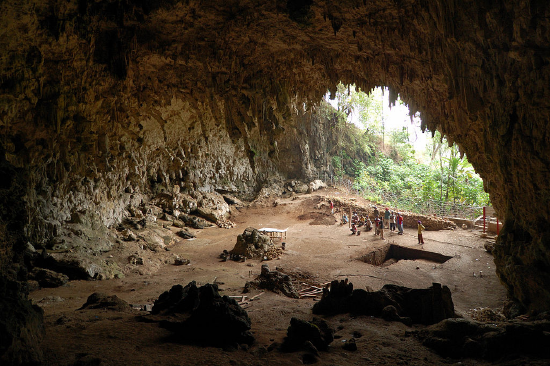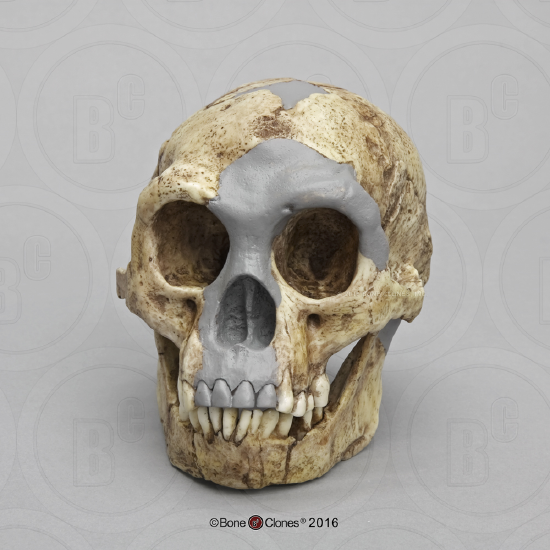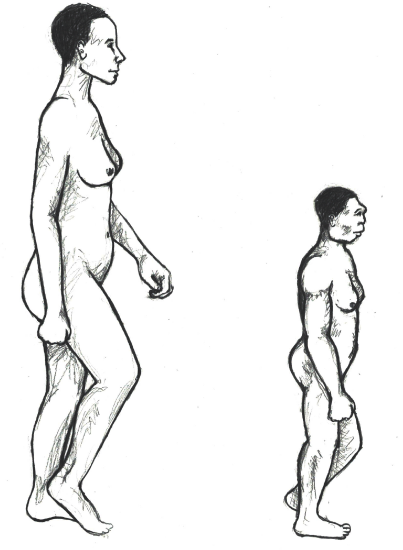11.1.9: How Do These Fit In? Homo Naledi and Homo Floresiensis
- Last updated
- Save as PDF
- Page ID
- 136454
Relatively recently, some fossils have been unearthed that have significantly challenged our understanding of the hominin lineage. The fossils of Homo naledi and Homo floresiensis are significant for several reasons but are mostly known for how they don’t fit the previously held patterns of hominin evolution. We’ll examine present information about both of these fossils, and we ask that you consider the wealth of evidence presented in this chapter and in others to draw your own conclusions regarding the significance and placement of these two unusual fossil species in the hominin lineage.
Homo Naledi
 Figure \(\PageIndex{1}\): A sample of some of the 1,550 bones found representing Homo Naledi.
Figure \(\PageIndex{1}\): A sample of some of the 1,550 bones found representing Homo Naledi.Found in 2013 by recreational spelunkers, a collection of bones was uncovered in a deep cave network in Johannesburg, South Africa. The cave system, known as Rising Star, had been well documented by other cavers; however, it appears few people had ever gone as far into the cave as these spelunkers had. Lee Berger, paleoanthropologist at University of Witwatersrand, in Johannesburg, immediately put out a call for what he termed “underground astronauts” to begin recovery and excavation of the fossil materials. Unlike other excavations, Berger and most other paleoanthropologists would not be able to access the site, as it was incredibly difficult to reach, and at some points there was only eight inches of space through which to navigate. The underground astronauts, all petite, slender female anthropologists, were the only ones who were able to access this remarkable site. Armed with small excavation tools and a video camera, which streamed the footage up to the surface, the team worked together and uncovered a total of 1,550 bones, representing at least 15 individuals, as seen in Figure 11.15. Later, an additional 131 bones, including an almost-complete cranium, were found in a nearby chamber of the cave, representing three more individuals (Figure 11.16). Berger called in a team of specialists to participate in what was dubbed “Paleoanthropology Summer Camp.” Each researcher specialized in a different portion of the hominin skeleton. With various specialists working simultaneously, more rapid analysis was possible of Homo naledi than most fossil discoveries.
The features of Homo naledi are well-documented due to the fairly large sample, which represents individuals of all sexes and a wide range of ages. The skull shape and features are very much like other members of the genus Homo, including features such as a sagittal keel and large brow, like Homo erectus, and a well-developed frontal lobe, similar to modern humans, yet the brain size is significantly smaller than its counterparts, at approximately 500 cc (560 cc for males and 465 cc for females). The teeth also exhibit features of later members of the genus Homo, such as Neanderthals, including a reduction in overall tooth size. Homo naledi also had unique shoulder anatomy and curved fingers, indicating similarities to tree-dwelling primates, which is very different from any other hominin yet found. The date on the species, which was obtained some time after the fossils were first analyzed, indicates that Homo naledi lived between 335,000 and 236,000 years ago. This has been perhaps the greatest shock of all about Homo naledi, as this places this fossil as a contemporary to modern Homo sapiens, despite the very primitive features it retains.

Other remarkable aspects of the find is the placement of the Homo naledi fossils and what it may suggest. To access the site, approximately 80 m from any known cave entrance or opening, a treacherous route would have had to have been taken—including moving through a portion that is just 25 cm wide at some points, known as “Superman’s Crawl.” The only way to get through this section is by crawling on your stomach with one arm by your side and the other raised above your head. Past Superman’s Crawl, a jagged wall known as the Dragon’s Back would have been very difficult to traverse. Below that, a narrow vertical chute would have eventually led down to the area where the fossils were discovered. While geology changes over time and the cave system likely has undergone its fair share, it is not likely that these difficult features arose after Homo naledi lived. This has made scientists curious as to how the bones ended up in the bottom of the cave system in the first place. It has been suggested that Homo naledi deposited the bones there, one way or another. Another competing idea is that a few individuals may have entered the cave system to escape a predator and then got stuck. To account for the sheer number of fossils, this would have had to happen multiple times. In contrast, if Homo naledi did deposit the bones, either through random disposal or intentional burial, this calls into question their symbolic behavior and other cultural traits, including the use of fire, to access a very dark cave system.
Homo floresiensis
 Figure \(\PageIndex{3}\): Liang Bua Cave on the island of Flores, in Indonesia, where a collection of Homo floresiensis specimens were discovered.
Figure \(\PageIndex{3}\): Liang Bua Cave on the island of Flores, in Indonesia, where a collection of Homo floresiensis specimens were discovered. Figure \(\PageIndex{4}\): Homo floresiensis had a brain that was remarkably small at 400 cc. Recent genetic studies suggest a common ancestor with modern humans that predates Homo erectus.
Figure \(\PageIndex{4}\): Homo floresiensis had a brain that was remarkably small at 400 cc. Recent genetic studies suggest a common ancestor with modern humans that predates Homo erectus.In a small cave called Liang Bua, on the island of Flores, in Indonesia, a small collection of fossils were discovered beginning in 2003 (Figure 11.17). The fossil fragments represent as many as nine individuals, including a nearly complete female skeleton. The features of the skull are very similar to that of Homo erectus, including the presence of a sagittal keel, an arching brow ridges and nuchal torus, and the lack of a chin (Figure 11.18). Homo floresiensis, as the new species is called, had a brain size that was remarkably small at 400 cc, and recent genetic studies suggest a common ancestor with modern humans that predates Homo erectus.
 Figure \(\PageIndex{5}\): A reconstructed comparison between an anatomically modern human and Homo floresiensis. As an adult, Homo floresiensis was approximately 1 meter tall and would have weighed under 30 kg.
Figure \(\PageIndex{5}\): A reconstructed comparison between an anatomically modern human and Homo floresiensis. As an adult, Homo floresiensis was approximately 1 meter tall and would have weighed under 30 kg.The complete female skeleton, who was an adult, was approximately a meter tall and would have weighed just under 30 kg, which is significantly shorter and just a few kilograms more than the average, modern young elementary-aged child. A reconstructed comparison between an anatomically modern human and Homo floresiensis can be seen in Figure 11.19. The small size of the fossil has earned the species the nickname “the Hobbit.” Many questions have been asked about the stature of this species, as all of the specimens found also show evidence of diminutive stature and small brain size. Some explanations include pathology; however, this seems increasingly unlikely as all fossils found thus far demonstrate the same pattern. Another possible explanation lies in a biological phenomena seen in other animal species also found on the island and which date to a similar time period. This phenomenon, called insular dwarfing, is due to limited food resources on an island, which can create a selective pressure for large-bodied species to be selected for smaller size, as an island would not have been able to support their larger-bodied cousins for a long period of time. This phenomenon is the cause of other unique species known to have lived on the island at the same time, including the miniature stegadon, a dwarf elephant species.
Homo floresiensis fossils have been dated to have lived on the island between 100,000 and at least 60,000 years ago. There is ongoing research and debate regarding Homo floresiensis’ dates of existence, with some researchers concluding that they lived on Flores until perhaps as recently as 17,000 years ago. Stone tools were also uncovered that have dates overlapping with those of the site and are similar in nature to other hominin stone tools found on the island of Flores. Homo floresiensis would have hunted a wide range of animals, including the miniature stegadon, giant rats, and other large rodents. Other animals on the island that could have threatened them include the giant komodo dragon. An interesting note about this island chain is that ancestors of Homo floresiensis would have had to access the open ocean in order to get there, as the nearest island is almost 10 km away, and there is little evidence to support that a land bridge connecting mainland Asia or Australia to the island would have been present. This would also have limited the number of other animals, including predators as well as human species, that would have had access to the island. Anatomically modern Homo sapiens arrived on the island around 30,000 years ago and may have lived there at the same time as Homo floresiensis, if some researchers’ later dates for Homo floresiensis’ occupation are correct. The modern population living on the island of Flores today believes that their ancestors came from the Liang Bua cave; however, recent genetic studies have determined they are not related to the Homo floresiensis species.
Homo naledi and Homo floresiensis are clear outliers when compared to their contemporary hominin species. Each has surprised paleoanthropologists for both their archaic traits in relatively modern times and their unique combination of traits seen in archaic species and modern species of humans. While these finds have been exciting, they have also completely upended the assumed trajectory of the human lineage, causing scientists to re-examine their previously held assumptions about hominin evolution and what it means to be modern. Add this to the developments being made using ancient DNA, other new fossil discoveries, and other innovations in paleoanthropology, and you see that our understanding of archaic Homo sapiens and others living during this time period is rapidly developing and changing. This is a true testament to the nature of science and the scientific method!

